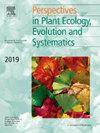Tillandsia landbeckii secures high phenotypic variation despite clonal propagation at the dry limits of plant life in the Atacama Desert
IF 3.5
3区 环境科学与生态学
Q1 ECOLOGY
Perspectives in Plant Ecology Evolution and Systematics
Pub Date : 2025-01-09
DOI:10.1016/j.ppees.2025.125846
引用次数: 0
Abstract
Hyperarid desert systems are among the most extreme and life-limiting biotas on Earth and lack almost any rainfall such as the Atacama Desert in northern Chile. In this study, we explored Tillandsia landbeckii loma vegetation consisting of only one single plant species that often covers square kilometers and is dependent on regular fog events as the most important water supply. We assessed growth and fitness parameters in the field and in cultivation; individual plants from nine permanent field study plots were collected and studied for phenotypic variation and plasticity under greenhouse conditions focusing on temperature and humidity. Individuals studied in the field and in cultivation have been genotyped using ddRAD analyses. The growth-related phenotypic variation shows very fine-scale adaptations to environmental gradients reflecting fog availability, and phenotypic variation is shown to be large. Genetic data indicate that Tillandsia landbeckii propagates mostly clonally, and various clones exhibit increased phenotypic variation and also prevail in the population. Our results suggest that while sexual reproduction is limited the long-lived Tillandsia landbeckii plant secures genotypes with high phenotypic variation via clonal propagation. As a consequence, a mosaic of such clonally reproducing vegetation units is securing not only genetic and phenotypic variation but also the integrity of the entire vegetation system thereby buffering environmental stress at the limits of vascular plant life. On longer time scales spanning hundreds to thousands of years, genetic variation is increased by rare and occasional gene flow, but the success of contemporary vegetation dynamics relies also on clonally reproduced ramets.
尽管无性系繁殖在阿塔卡马沙漠植物生命的干燥极限,但蓝背莲确保了高表型变异
极度干旱的沙漠系统是地球上最极端和限制生命的生物群落之一,几乎没有任何降雨,比如智利北部的阿塔卡马沙漠。在本研究中,我们探索了仅由单一植物物种组成的landlandsia landbeckii loma植被,这些植被通常覆盖平方公里,并且依赖于常规雾事件作为最重要的供水。我们评估了田间和栽培中的生长和适宜性参数;收集了9个永久田间研究样地的单株,在以温度和湿度为重点的温室条件下研究了表型变异和可塑性。在田间和栽培中研究的个体已使用ddRAD分析进行基因分型。生长相关的表型变异对反映雾效度的环境梯度表现出非常精细的适应,表型变异显示出很大的差异。遗传数据表明,蓝背莲主要是无性系繁殖,各种无性系表现出表型变异,在群体中也普遍存在。我们的研究结果表明,虽然有性繁殖受到限制,但长寿的蓝背莲植物通过无性繁殖获得了具有高表型变异的基因型。因此,这种无性繁殖的植被单元的马赛克不仅保证了遗传和表型变异,而且保证了整个植被系统的完整性,从而缓冲了维管植物生命极限时的环境压力。在数百年至数千年的更长时间尺度上,遗传变异会因罕见和偶尔的基因流动而增加,但当代植被动态的成功也依赖于无性繁殖的分株。
本文章由计算机程序翻译,如有差异,请以英文原文为准。
求助全文
约1分钟内获得全文
求助全文
来源期刊
CiteScore
6.50
自引率
0.00%
发文量
28
审稿时长
67 days
期刊介绍:
Perspectives in Plant Ecology, Evolution and Systematics (PPEES) publishes outstanding and thought-provoking articles of general interest to an international readership in the fields of plant ecology, evolution and systematics. Of particular interest are longer, in-depth articles that provide a broad understanding of key topics in the field. There are six issues per year.
The following types of article will be considered:
Full length reviews
Essay reviews
Longer research articles
Meta-analyses
Foundational methodological or empirical papers from large consortia or long-term ecological research sites (LTER).

 求助内容:
求助内容: 应助结果提醒方式:
应助结果提醒方式:


